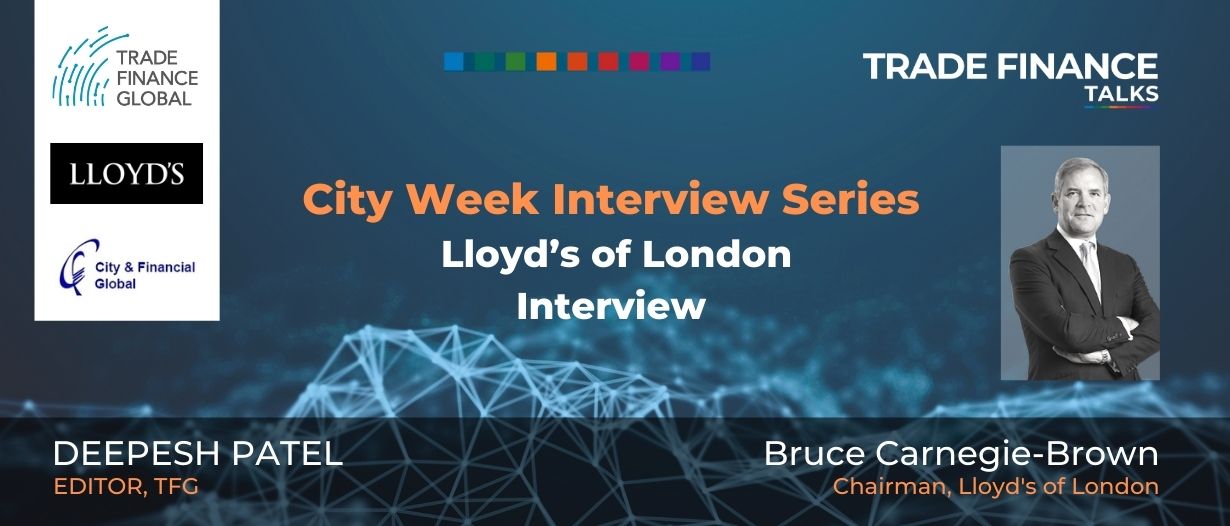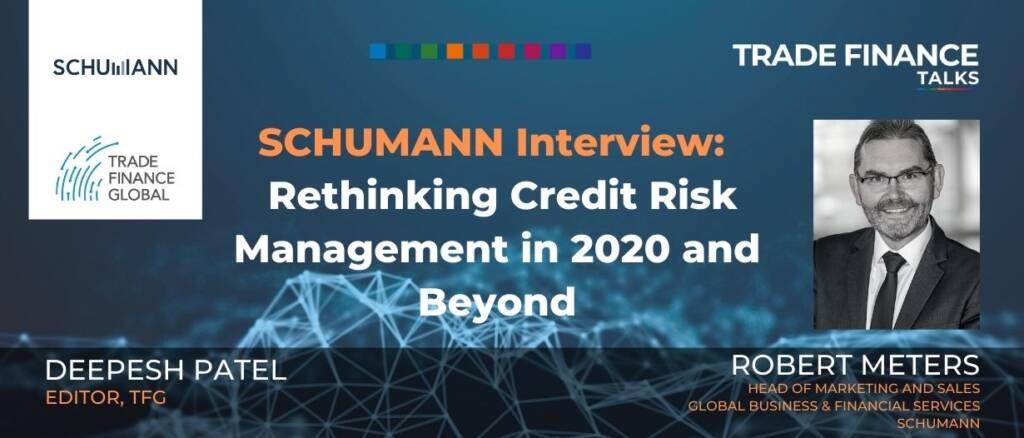TFG heard from Chairman of Lloyd’s of London, Bruce Carnegie-Brown, on the critical Covid-19 related challenges faced by the 300-year-old institution, as well as what could be in stock for the longer-term future of the Lloyd’s market.
Bruce Carnegie-Brown will be speaking at City Week 2020, TFG’s partner conference by City & Financial.
Featuring: Bruce Carnegie-Brown (BB), Chairman, Lloyd’s of London
Host: Deepesh Patel (DP), Editor, Trade Finance Global
Deepesh Patel (DP): Thank you so much for doing this with us! What is your “backstory”? Tell us a little more about your role as the 63rd Chairman of Lloyd’s of London
Bruce Carnegie-Brown (BB): The Chairman of Lloyd’s is certainly a unique role, and it is a great privilege to be asked to head up one of the City’s great institutions. In terms of my “backstory”, I went straight into the banking industry out of university and spent the majority of my banking career at JP Morgan. In 2003 I had the opportunity to move out of banking and into the world of insurance as the CEO of Marsh’s UK and EMEA operations. Since moving away from full-time executive positions, most of my non-executive work has been with banks like Santander and Close Brothers or insurance businesses like Aon, JLT Group, and Catlin. I have also had an opportunity to immerse myself in the digital world as the Chairman of Moneysupermarket Group and more recently as the chairman of the digital motor insurer, Cuvva. Since starting at Lloyd’s in 2017, my focus has been on improving the financial and operational performance of the market, as well as leading initiatives to make the market a more diverse and inclusive place to work. But all of this only happens with the support of colleagues working across Lloyd’s market.

Lloyd’s of London – An Overview
DP: What role does the Lloyd’s market play and what benefits does it bring to its customers?
BB: Insurance has a vital role to play in underpinning the risks taken by our customers. For over three centuries the security of Lloyd’s has protected what matters most to people, businesses, and communities and helped them recover in times of need. A key benefit our market brings to customers is our scale. More than 50 leading insurance companies, 200 registered Lloyd’s brokers and 4,000 local coverholders operate in and bring business to the Lloyd’s market. Our competitive market helps to ensure customers receive the best possible outcomes across price, coverage and service.
Challenges of Covid-19 on the insurance industry
DP: How can Lloyd’s help foresee and support businesses who are struggling as a result of decreased trade and negative economic growth?
BB: COVID-19 has resulted in a humanitarian and economic crisis on a scale the world was underprepared for. Lloyd’s is committed to working with other insurance companies and with governments around the world to provide short, medium, and long-term solutions to the challenges faced by our customers as they begin to recover and re-open.
Our aim is to stimulate innovation and accelerate development by proposing new solutions that could be developed and adopted by the global insurance industry. We have outlined three proposed ‘open source’ frameworks that are freely available for application around the world, two of which (RecoverRe and Black Swan Re) require partnership between governments and the (re)insurance industry. The proposals include solutions for the reopening of businesses against the threat of further waves of COVID-19, building greater resilience across global supply chains as well as the digital economy, and preparation and protection for the next systemic catastrophic event. More broadly, insurance naturally responds to the changing economic environment: if there is less trading activity, customers’ insurance needs will be less and premium payments will fall.
Emerging Technologies and Quantifying Credit Risk
DP: Can advances in data collection and analysis, coupled with new and emerging technologies (e.g. machine learning, artificial intelligence) help Lloyd’s underwriters better quantify credit risk? How so?
BB: Yes, these advances can help underwriters. Simply put, data and data analytics are transforming how insurers work. The amount of data available is increasing hugely as people and businesses become more connected; the development of the internet of things will increase this data exponentially, and with more data and better analytics comes greater customer insight. This can be used to create insurance products that are better tailored to individual customer’s risk profiles, helping them to mitigate their risks and lower their premiums.
The future of Lloyd’s of London
DP: How do you see the future competitive positioning of Lloyd’s on the global insurance stage?
BB: We will secure the long-term future of the London market by putting our customers at the heart of our thinking. Insurance has supported human endeavour for centuries, helping society make the leaps in innovation that have characterised its development over time. Customers’ risks are changing faster than ever. The COVID-19 pandemic is an example of this. Our customers face new threats to new types of tangible and intangible assets in new geographies and we need to develop new products and services that can address these needs building greater trust with customers, supercharging innovation to deliver products and services more closely aligned to their needs, and reducing policy costs, will go a long way towards achieving our ambition for the next decade.
DP: What is next on the agenda for you, in your role as Chairman of Lloyd’s of London, in the short to medium-term future?
BB: The immediate focus for Lloyd’s and our market right now is COVID-19 and the immediate needs of our customers. We expect to pay out £5 billion for COVID-related claims in 2020 and we will continue to provide support and solutions to help customers navigate through the pandemic. But we are also continuing to execute against our medium-term ambition to create the world’s most advanced insurance marketplace. The pandemic has underscored the importance of our “Future at Lloyd’s” investment plans and we have sharpened our focus to prioritise development in three key areas that would deliver the most impact and value to the market and our customers: improving electronic placement, enhancing Delegated Authority services, and making improvements to claims processes. Alongside these priorities, we will progress work on the data and technology capabilities we need to support our ambitions. We’ll be launching the “Future at Lloyd’s” Blueprint update in November this year, which will set out in more detail the roadmap for 2021 and beyond.
Also, as part of our aim to improve performance and deliver on our strategy we are committed to driving long term culture change across the Lloyd’s market. Earlier this year we set market-wide gender targets and published a Culture Dashboard. This marked the fulfilment of the commitments we made in 2019 and builds a foundation for our ongoing initiatives to build a more inclusive environment for all. We will also be setting a market-wide target for ethnicity in 2021, which follows Lloyd’s five initial actions to help improve the experience of Black and Minority Ethnic talent in our market.

DP: As an inspirational leader and role model in the ever-changing financial services space, what advice would you give to people entering this industry in the coming months, given the current market conditions?
BB: I think there has never been a more exciting time to work in the insurance industry. The risks faced by our customers continue to change and develop at an ever-faster pace, driven by many factors, including technology, climate change, globalisation, and population growth. The analysis of large data flows in making informed decisions is becoming more and more important, but all of this ultimately relies on human judgement and the quality of the advice and expertise we can provide to our customers. In joining the insurance industry, you are joining an industry with a strong purpose and a vital role to play in helping governments, businesses and individuals build resilience as they navigate their way in an ever more complex and risky world.




































